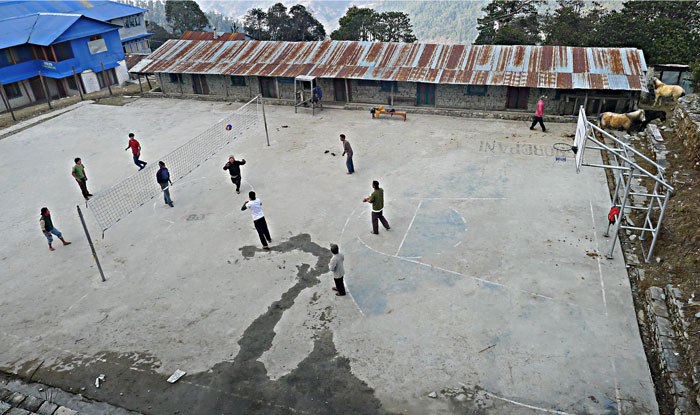On the road to Shangri-La, #3
Mar 25, 2011
 There are two kinds of trekking in Nepal: teahouse trekking through populated countryside and tent trekking, which can venture into uninhabited mountain realms of rock and ice. Both kinds involve a group of tourists walking on trails for days or weeks, led by a guide and supported by porters.
There are two kinds of trekking in Nepal: teahouse trekking through populated countryside and tent trekking, which can venture into uninhabited mountain realms of rock and ice. Both kinds involve a group of tourists walking on trails for days or weeks, led by a guide and supported by porters.
The trekkers in the group usually carry only daypacks as they walk, containing bottled water, a fleece and rainjacket, toilet paper, and little more. Porters for teahouse treks carry duffels containing clothes and sleeping bags; for tent treks, they also carry food, camping gear, and perhaps mountaineering equipment. For a teahouse trek, there is one porter for every two or three trekkers in the group. For a tent trek, the ratio may be much higher.
Porters are ridiculously strong, fit, sturdy, reliable people. Most but not all are male, though they are not big men; some are barely five feet tall. They load up with 60 or 80 or even 100 pounds on their backs and oftimes finish the day's hike long before the lightly-laden trekkers. Many of them come from extremely remote villages, where subsistence farming is still the mainstay of life and there is little or no opportunity to earn cash income. Many porters, like most Nepalis, are illiterate. Work with the trekkers is seasonal and extremely irregular, and the pay is poor.
The two porters who accompanied our little group came from the Forbidden Kingdom of Mustang, high in the Himalayas near the Tibetan border. The provincial government of Mustang keeps the district almost closed to foreigners by charging so much for visas that only the wealthiest tourists can visit. Each year, as trekking season comes around, would-be porters in places like Mustang have to somehow come up with cash money--often borrowed--for bus fare to Kathmandu, where they gather in the airport parking lot to be looked over by trekking guides and perhaps chosen for work.
The guide for our group, Binaye, a Nepali who usually worked for a German tour company but who handled our trip on his own, went out to the airport to hire porters a few days before we were scheduled to arrive. He knew nothing about the two men he chose and had never met them before; he liked their attitude, he said, and they didn't smell of booze. From their homes in Mustang, they had walked four days to the bus stop and then ridden the bus for three days to Kathmandu, with no guarantee of work.
Both of them were among the pleasantest, hardest working people I've ever met.
After three days' trek, we reached the village of Ghorepani, a trekking hub. Many routes lead out from Ghorepani into the high Himalaya around Annapurna. The place bustled with trekkers coming and going, and over the years, trekking-related income had apparently led to public amenities not evident in smaller villages. Ghorepani had electricity and a medical clinic of some kind, and also a school.
Outside the school was a playground, a paved yard with a basketball goal and a volleyball net. Mule trains and horse caravans trooped across the back of the lot. Wastewater from a restaurant kitchen spilled in from the front.
As we settled into town to catch our breath and wait for dinner, porters were out in the playground playing volleyball. They had set down their loads, taken off their boots, and somehow found the energy to run and jump and dive and enjoy the late-afternoon sun.
Porters and trekkers eat separately and mostly have little communication or contact; per tradition, we come together for drinks the last night of the trip. That's when I learned that Beem, the porter with a hat and scarf and permanent smile, had five children, just like me.
